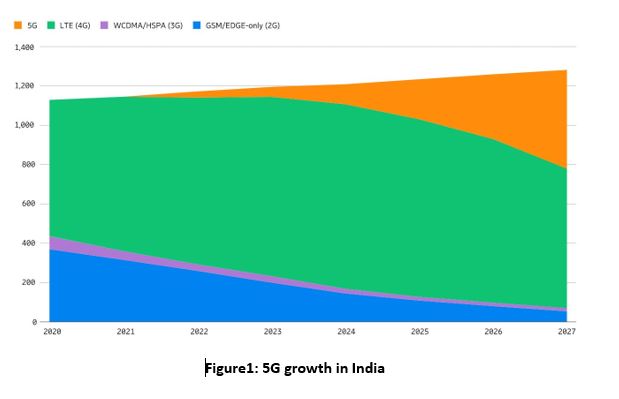How E-band spectrum offers new 5G opportunities in India
by Dan Rhodes, Business Development Director, Filtronic
Among the world’s largest economies, India has long been regarded as an underexploited market for telecommunications. With India’s cities having a high proportion of young, technology-literate residents, it is something of an anomaly that the country’s statistics for fixed and mobile broadband connections still remain relatively low. A key reason for this is that, due to its large land mass and widely-distributed population, it has proved difficult to connect much of the country with fibre, and indeed there has also been a historically low level of telephone and Internet connections over copper. A 2019 report by GSMA[1] estimated that India then had just 1.5 million kilometres of optical fibre cable, with less than a quarter of its mobile masts connected by fibre, meaning that Indian operators are more reliant on microwave backhaul than many other countries.
5G deployment
In a June 2022 report[2] commissioned by Ericsson, Omdia found that 52% of Indian enterprises it surveyed expressed a wish to start using 5G services within the next 12 months. Figure 1 from the same report demonstrates the significant growth of 5G within India from 2023 onwards. With the lack of installed infrastructure, using wireless backhaul links to roll out 5G networks is an obvious way to move forward, and is likely the only way to start addressing this huge demand. In recognition of this, and following petitions[3] from the ITU APT Foundation of India to the country’s Telecom Minister, there are now plans[4] by the Indian Department of Telecommunications to open up the spectrum at E-band (71 – 76 GHz and 81 – 86GHz) for backhaul, to support 5G network rollouts. At the same time they are delicensing V-band for WiFi services. These bands may be allocated via an auction process, or possibly by an alternative method of allocation, but a spectrum charge is expected to be applied to the network operators.

UK-India collaboration
The potential of the Indian market has also attracted the attention of the UK Government. Back in October 2021, UK Research and Innovation (UKRI) announced[5] that it was funding two collaborations between the UK and India, aimed at boosting 5G networks and future generations of telecoms. One is a grant to the Compound Semiconductor Applications Catapult to explore opportunities for further collaboration. The second is the UK-India Future Networks Initiative (UKI-FNI), a £1.4 million project involving UK and Indian universities and led by the University of East Anglia. The main aim of the project is to build relationships between the two countries towards increasing capability and capacity in 5G, and in developing telecoms diversification technologies for 5G and beyond. It is also intended for India and the UK to jointly develop a roadmap and research strategy for 5G and 6G, funded by UKRI India and UKRI’s Engineering and Physical Sciences Research Council (EPSRC).
Diversification
A key path toward diversification is the OpenRAN movement, under which the key elements of the radio access network (RAN) can be separated or disaggregated into individual elements. These can be sourced from a wider range of suppliers, and offers an approach that is likely to be favoured in India as the country starts to build up its own domestic telecoms supply chain.
The key functional elements of the RAN – the Radio Unit (RU); the Distributed Unit (DU); and the Central Unit (CU) – need to be connected with each other via either optical fibre or an ultra-high-capacity wireless link, with the new connection between the RU and DU being called fronthaul, and that between DU and CU being named midhaul, as shown in Figure 2. Together with backhaul, these links are collectively known as Xhaul.

Suitability of E-band for Xhaul
Filtronic has been delivering E-band transceivers for backhaul for several years, and believes that wide-bandwidth mmWave radios represent the optimum solution to meet the increasing capacity demands for all types of Xhaul in 5G communications systems and beyond.[6] The proven ability of mmWave links to provide an equivalent capacity to fibre — up to 40 Gbps in multichannel configurations, over distances of up to 10km — combined with their ease and comparative low cost of deployment make them ideal for helping India meet its demanding telecoms market needs.
References
[1] “India: Becoming 5G-Ready”, 2019, GSMA, https://data.gsmaintelligence.com/api-web/v2/research-file-download?id=42565634&file=2758-140519-5G-India.pdf [2] “Mapping 5G’s future in India”, June 2022, Omdia (commissioned by Ericsson) [3] https://economictimes.indiatimes.com/industry/telecom/telecom-policy/itu-member-body-seeks-opening-of-e-band-for-5g-backhaul-v-band-for-wi-fi/articleshow/89866389.cms [4] https://economictimes.indiatimes.com/industry/telecom/telecom-news/telcos-to-get-key-e-band-waves/articleshow/93146040.cms [5] https://www.ukri.org/news/uk-india-collaborations-announced-during-foreign-secretary-visit/ [6] “What Can mmWave Do For 5G Backhaul?”, Mike Geen, 9 October 2019, RF Globalnet https://www.rfglobalnet.com/doc/what-can-mmwave-do-for-g-backhaul-0001 [7] “India’s 5G future: a closer look”, 2022, Ericsson https://www.ericsson.com/en/reports-and-papers/mobility-report/closer-look/indiaIf you are looking to deploy E-band in India or elsewhere and are looking for the leading transceiver module, diplexer or SSPA, then contact the E-band specialists at Filtronic can offer the expertise and advice you need.
Find out more about Filtronic’s capabilities:
- RF Solutions for Public Safety Critical Communications
- Aerospace and defence applications
- Telecommunications
- RF Solutions for Space
- RF Testing and Measurement

